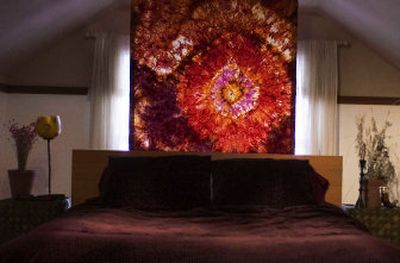Fabric can replace paint

After many months of work and many thousands of dollars spent, Misti McFarland and family were ready to move into their newly-remodeled North Side home. Nearly every surface had been redone with several rooms being finished for the first time ever; except for the downstairs laundry room. They just ran out of steam at that point, and it retains its original concrete and exposed 2x4 walls. What’s more, a member of her extended family moved in, using up the last bedroom.
“We originally weren’t going to put a bed in it or anything, but I thought if we did have people over it would be nice if they had a place to go,” McFarland said.
McFarland put her finely honed bargain shopping skills to work and came home with seven black, and black-and-white patterned shower curtains purchased at $5 a piece and a bolt of fabric for a $1 a yard.
Two hours, a bed and a lamp later, the ugly, barren laundry room had been transformed into a dark and cozy little cave of a guest room. It’s not very big, but it’s private and quiet and guests can feel like they’re in a bedroom rather than the utility room.
Use fabric not paint
Dark brown paneling in a rental that you’re not allowed to touch no matter how hideous, water heaters in the kitchen, or concrete walls you can’t afford to finish are all major sore spots in many homes – especially among first-time home buyers and renters.
Sometimes changes can only be temporary, or maybe all you want to do is add a quick bit of coziness without breaking the budget.
Creative use of fabric can often go a long way toward dealing with decorating headaches and it can be far more affordable than you think.
An hour spent dragging your hand along plush fabrics, comparing colors, feeling textures, can take you one step closer to your dream room. Hundreds of patterns are available, often for as little as a dollar a yard. Pick your problem, and there’s a bolt to match it.
Dark paneling form the ‘70s can be quickly covered using one by half inch strips of wood, a staple gun, finishing nails and a your favorite bolt of cloth. After picking the perfect cloth, measure and staple it to the wooden strips, pleating every few inches, then roll the strip and attach it near the ceiling and baseboard. Small patterns work best; large ones can cause major headaches when trying to line up. Rearrange your furniture and sit back to enjoy your brand-new room.
Small rooms – bold solutions
A long, narrow attic bedroom presented unique challenges to Marni Solheim when she purchased her home. Windows situated at the far ends of the room let in little light, a situation that would be exacerbated with the use of traditional curtains, and the disproportionate dimensions caused furniture to look either crowded onto a wall or like it was free-floating in space.
A unique room called for a unique solution: a large square of colorful fabric stretched over a 4-by-4-foot frame now works as a unique window covering, a headboard and a room divider – all in one piece. The fabric floats above the bed like a piece of art. Not being attached to the wall or directly covering the window, it allows better air circulation in the un-air conditioned attic, at the same time as it provides much needed privacy.
This concept translates well to dorms rooms or rooms shared by siblings. A small false wall, hung between twin beds on chains from the ceiling, can give a valuable feeling of privacy. Young adults sharing a room for the first time or young adolescent sisters, who desperately need their privacy, can even choose their own colors to match their budding personalities. Friends and family are still nearby, but at least they don’t have to stare at the back of each other’s heads when trying to sleep. A little fabric can go a long way toward keeping the peace.